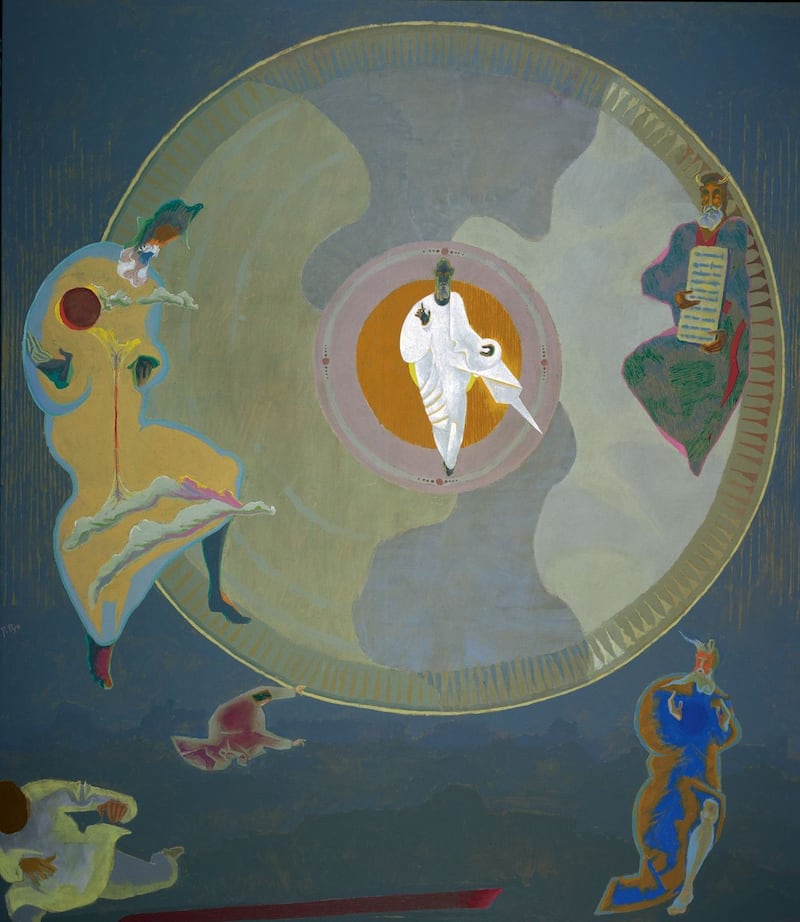Patrick Pye
Born: April 10th, 1929
Died: February 8th, 2018
The artist Patrick Pye, who has died in his 90th year, was one of the leading Irish religious artists of the 20th century. Many of his works, whether in painting, stained glass or graphic media, directly address biblical themes, but even his more secular pieces – he was a very accomplished still-life painter – are shaped by and infused with his core religious convictions. He was also a thinker and commentator preoccupied by the nature and meaning of art, with a book on El Greco, The Time Gatherer, and numerous other writings to his credit. He edited the annual arts journal Introspect and was a founder member of the Independent Artists and Figurative Image groups.
Patrick Pye was born in the English cathedral city of Winchester, the only child of Peter Pye, an anaesthetist and prize-winning blue-water sailor who wrote several books on sailing, and his Irish wife, Dorothy (née Neville), a piano teacher. The marriage was unhappy, and when Patrick was four his mother returned to Dublin with him. They lived in Templeogue, on the banks of the River Dodder. He subsequently saw his father on many occasions, but their relationship was at best strained.
El Greco's highly distinctive, ecstatic mode of religious painting dovetailed with Pye's developing interest in Catholicism, and he determined to be an artist
Largely through his mother’s example, Pye acquired early on a lifelong appreciation of music, which he said informed his painting. Although she was not well off, his mother had a circle of friends that included artists, Patrick Hennessy among them, and others versed in the arts and literature. After national school Pye’s English aunts, of whom he always remained fond, financed his attendance at St Columba’s College, not far from Templeogue, as a boarder. The sculptor Oisín Kelly was the art teacher there. “He pointed out the weaknesses in my work, which was helpful,” Pye later remarked, without irony.
His talent was quickly recognised – he showed at the annual Irish Exhibition of Living Art aged only 16 – and his interest in art blossomed when he came across an illustrated book on El Greco in the school library. El Greco's highly distinctive, ecstatic mode of religious painting dovetailed with Pye's developing interest in Catholicism, and he determined to be an artist. His mother, nominally a Protestant, was not actively religious and, not unreasonably, viewed religion as divisive. He refrained from converting to Catholicism until he was in his early 30s, after her death.
Sporadic attendance at the National College of Art and Design, in Dublin, in the 1950s alternated with visits to Europe. He studied stained glass in the Dutch city of Maastricht and went on to open his own stained-glass studio. His rapt encounter with the Catalan Romanesque, in Barcelona, was artistically decisive, cementing his instinctive identification with pre-Renaissance art, particularly the sacred art of Byzantine and Orthodox churches. Equally importantly, he also went to Toledo to see El Greco’s work. The formation of his own mature style, with its staccato geometric rhythms and highly stylised figuration, its eschewal of classical perspective, its intense spirituality and its radiant palette, can be traced to these influences.
In the latter half of the 1960s he moved to a small, chilly cottage in Piperstown, in the highlands beyond Tallaght, on the southwestern edge of Dublin (building a studio there only in the early 1970s). The relative isolation and distance, and difficulty of access, contributed to Pye’s reputation as something of a religious ascetic. “He is more a figure of the desert than the drawing room,” as Philip McShane OP wrote in an illuminating commentary on his work in 2004. But in 1974 he married the weaver Nóirín Kennedy. Apart from anything else, he benefitted greatly from her organisational abilities, and he flourished in Piperstown, enjoying several exceptionally productive decades there.

Although religious figuration was, for a substantial part of Pye's career, conspicuously out of fashion, he always enjoyed the respect of a significant number of fellow artists and writers and of members of the wider public; Maynooth University awarded him an honorary doctorate, and he was a founding member of Aosdána. And fashions change: his work featured prominently in Imma's 2017 exhibition As Above, So Below, for example. For many years he showed with the David Hendriks Gallery, in Dublin, then Ireland's leading modernist commercial gallery, and there was a retrospective at the RHA in 1997. Major stained-glass works can be seen at many locations, including Glenstal Abbey, St Mary's Church in Westport, St Michael's Church in Dún Laoghaire, Church of the Resurrection in Killarney, and the Catholic Cathedral of St Mary and St Anne, in Cork.
He is survived by his wife, Nóirín, and daughters, Róisín and Naoise.














